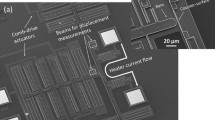Abstract
The selection of the proper materials for the fabrication of the micro electro mechanical systems (MEMS) is a very important issue in the MEMS research. The materials should be adequate for the fabrication process as well as they have to demonstrate in particular good adhesive (to avoid stiction between contacting/sliding components) and frictional/tribological properties. We fabricated ultrathin (50 nm thick) polysilicon films on single crystal silicon wafers at various deposition process conditions and observed the effect of the process parameters on surface topography and adhesive as well as frictional properties of the produced films. The atomic force microscope was used in these studies equipped with special cantilevers. We identified interesting correlations between the process parameters and adhesive/frictional properties of the studied films which enable to optimize the process to decrease adhesion (stiction) and friction between sliding components of MEMS devices and compared them to previous research done at samples with thicker layer. Topography of both samples and cantilevers has been studied in depth to allow later simulation of the interface. Additional measurements of friction in various humidites should be done next in order to assess the influence of its impact on friction coefficient. Further comparison of adhesion to friction in particular environmental properties might also increase our understanding of MEMS surface interactions.








Similar content being viewed by others
References
Achanta S, Celis JP (2015) Nanotribology of MEMS/NEMS. In: Gnecco E, Meyer E (eds) Fundamentals of friction and wear on the nanoscale. NanoScience and technology. Springer, Cham
Brand O (2005) Fabrication technology. In: Brand O, Fedder GK (eds) CMOS - MEMS. Wiley-VCH Verlag GmbH, Weinheim, Germany
Hartzell AL, da Silva MG, Shea H (2011) MEMS reliability. Springer, Berlin
Jarzabek D, Rymuza Z, Ohmae N (2009) Friction and adhesion of carbon nanotube brushes. Int J Mater Res 100:973–977
Jarzabek D, Kaufmann A, Schift A, Rymuza Z, Jung T (2014) Elastic modulus and fracture strength evaluation on the nanoscale by scanning force microscope experiments. Nanotechnology 25:21
Madou MJ (2012) Fundamentals of microfabrication and nanotechnology, vol I–III, 3rd edn. CRC Press, Boca Raton
Rabinowicz E (1995) Friction and wear of materials, 2nd edn. Wiley, New York, p 315
Sinha SK, Sujeet K, Satyanarayana N, Lim SC (eds) (2013) Nano-tribology and materials in MEMS. Springer, Berlin
Voicu R, Michalowski M, Rymuza Z, Gavrila R, Obreja C, Müller R, Baracu A (2014) Design and analysis of polysilicon thin layers and MEMS vibrating structures. In: Proceedings DTIP 2014—SYMPOSIUM on design, test, integration and packaging of MEMS/MOEMS, Cannes Côte d’Azur, France, pp 129–133
Voicu R, Baracu A, Gavrila R, Obreja C, Danila M, Dinescu A, Bita B, Müller R (2015) Material characterizations for MEMS vibration sensors and biostructures applications. Dig J Nanomater Biostruct 10(3):1077–1085
Yang S, Zhao Y, Jiang Z, Liu Y, Tian B (2013) A micro-force sensor with slotted-quad-beam structure for measuring the friction in MEMS bearings. Sensors 13(10):13178–13191
Zhang W, Meng G, Li H (2005) Electrostatic micromotor and its reliability. J Microelectron Reliab 45(7–8):1230–1242
Acknowledgements
The fabrication of the films carried out by the authors from IMT has been also supported by the Sectoral Operational Programme Human Resources Development 2007–2013 of the Ministry of European Funds through the Financial Agreement POSDRU/159/1.5/S/132397 and by the Romanian Contract Nucleu No. 15N/2016 TEHNOSPEC (TEHNOlogii generice esenţiale pentru prioritaţi ale SPECializarii inteligente).
Author information
Authors and Affiliations
Corresponding author
Rights and permissions
About this article
Cite this article
Michałowski, M., Voicu, R., Obreja, C. et al. Influence of deposition temperature during LPCVD on surface properties of ultrathin polysilicon films. Microsyst Technol 24, 537–542 (2018). https://doi.org/10.1007/s00542-017-3501-y
Received:
Accepted:
Published:
Issue Date:
DOI: https://doi.org/10.1007/s00542-017-3501-y




